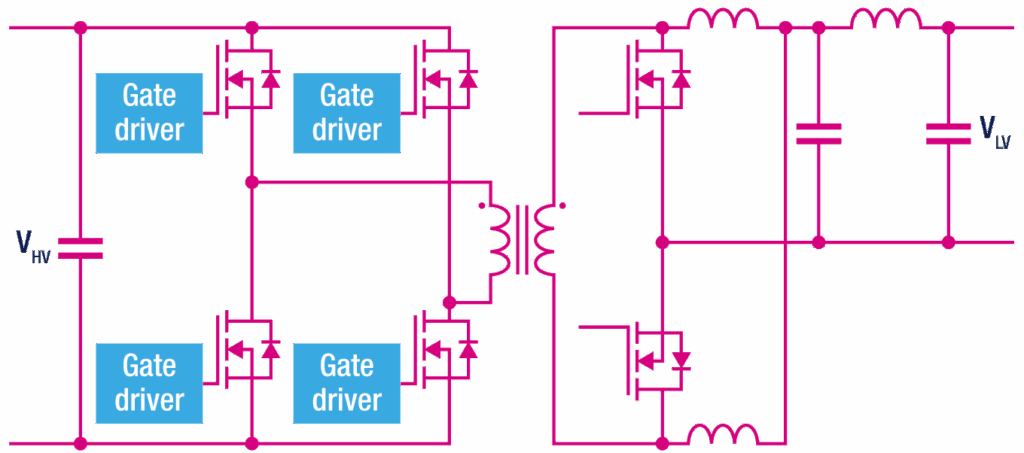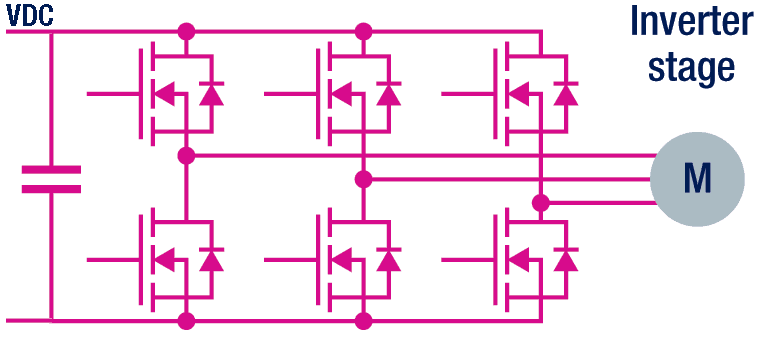Electric car sales reached 750,000 vehicles worldwide in 2016[1]. China alone represented over 300,000 vehicles. And there are forecasts of between 40 and 70 million Electric Vehicles being deployed by 2025[2]. All these data points indicate that the electrification of vehicles is increasing at an incredible pace, driven by cheaper battery technology, acceptable mileage, and performance and ecological awareness. Many countries provide incentives to switch to electric vehicles and charging infrastructures are becoming more widespread. A lot of semiconductor content is needed to fuel this demand for electric vehicles but let’s focus on Power Discrete Devices and see how they enable the Electrification revolution.
There are 3 main areas in electric vehicles (both hybrid and pure electric vehicles) where power semiconductors play a key role. The on-board-charger, the DC/DC converter, and the Traction inverter.
On-Board Charger
The onboard charger or OBC is integrated into the car. It converts energy coming from the grid (110VAC or 220-240VAC) to a DC voltage required internally to charge the battery. The DC voltage is typically 400V DC, but 800V DC is also used to provide faster charge times. In “Home Charge” applications, the charge time depends on subscriber’s electricity contract, e.g. 3.3 kW max, single phase. This charge is relatively slow, taking 8 to 12 hours to fully charge the vehicle’s batteries, compared to DC Fast Charge and EVSE charge stations, but the power source has the advantage of being widely available.

The block diagram shows a simplified OBC, with AC/DC, PFC, and DC-DC converter stages.
OBC AC/DC Converter 650V (for 400V batteries) and 1200V (for 800V batteries) diodes are available to build solutions for all the charger output specifications (7 KW, 11 kW, and 22 kW).
OBC Power Factor Corrector (PFC) requires matched MOSFETs and a diode. ST’s silicon “Hard Switching” MOSFETs and Silicon Carbide solutions in 650V and 1200V forms offer price/performance choices for designers.
OBC DC/DC Converter. 650V and 600V “Soft Switching” MOSFETs
DC/DC converter
Traditionally, car electronics were powered from a DC voltage of 12V. Despite electric vehicles now having 400V batteries instead of 12V, they will continue to use 12V for applications such as interior lighting, infotainment equipment, and window lift motors. A DC-DC converter converts the 400V at the batteries to the 12V DC for these applications. DC-DC converters are also used to convert HV to 48V, 48V to 12V and other conversions depending upon the topology of the EV.

The diagram shows a simplified DC-DC converter, where VHV represents the high voltage battery, and VLV the low voltage one.
For the DC/DC Converter HV side. 650V and 600V “Soft Switching” MOSFETs in TO247 and D2PAK packages
For the DC/DC Converter LV side. Low Voltage Power MOSFETs, typically with a 40V rating. ST’s leading edge Trench gate power MOSFETs are perfect and available in different packages.
Traction Inverter
The traction inverter provides the main electric motor with its power. This is then used to drive the wheels and control the speed of the vehicle. In a typical configuration, the electric motor requires 3 phase AC voltage. This is why the traction inverter is sometimes called a “DC-AC converter”. The output power can commonly reach up to 85 kW.

Up until recently, the power device of choice for inverters was an Insulated Gate Bipolar Transistor or IGBT. IGBT’s can switch up to 200A, with a 650V rating, sufficient for inverter design. As shown in the diagram, each IGBT is associated with a 650V external power “free-wheeling” diode to eliminate high voltage spikes caused by the inductive nature of the load presented by the AC motor. However, the IGBT solution is inefficient when the loading is low (below 40%), leading to energy losses and a reduction in the range of the vehicle.
An alternative to IGBTs is Silicon Carbide (SiC) MOSFETs. These devices, in 650V and 1200V versions, are now becoming available in automotive grade. SiC technology provides unrivaled switching performance across the load range to minimize losses and also eliminates the need for “free-wheeling” diodes. Smaller die sizes plus higher operating temperatures and power output mean that a SiC-based inverter can be smaller and require less cooling than an IGBT solution, lowering the weight of the inverter too and increasing the potential range of the vehicle.
ST’s investment in 6” wafer capacity is supporting the increased uptake of SiC technology for vehicle electrification. The system cost for the car manufacturer basing their inverter designs on SiC technology is lower, enabling cheaper yet higher performance electric cars. In particular, SiC technology is helping reduce the cost of expensive and complex cooling systems.
Electric vehicles represent one the fastest growing applications requiring Power Discrete components. ST is a leader in the field and has invested heavily in the technology to gain more than any other company from vehicle electrification.
To find out more about ST’s products for vehicle electrification click here
